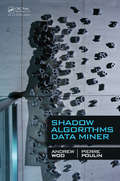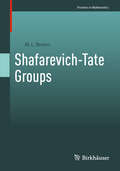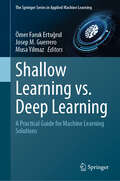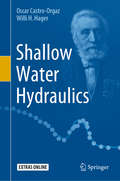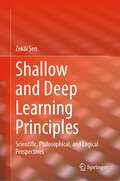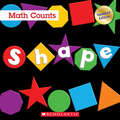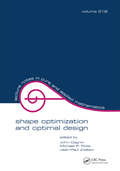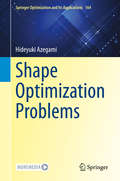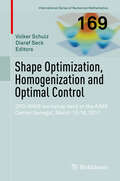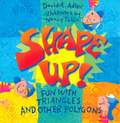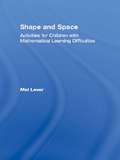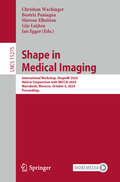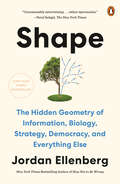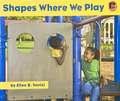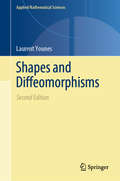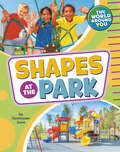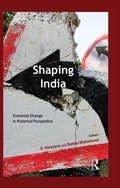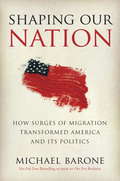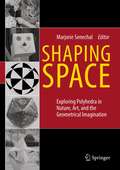- Table View
- List View
Shadow Algorithms Data Miner
by Andrew Woo Pierre PoulinShadow Algorithms Data Miner provides a high-level understanding of the complete set of shadow concepts and algorithms, addressing their usefulness from a larger graphics system perspective. It discusses the applicability and limitations of all the direct illumination approaches for shadow generation.With an emphasis on shadow fundamentals, the boo
Shafarevich-Tate Groups (Frontiers in Mathematics)
by M.L. BrownThis monograph explores the finiteness and structure of Shafarevich-Tate groups of abelian varieties over global fields of any characteristic. Readers will better understand how the methods of Euler systems and Kolyvagin systems can be adapted to Heegner points and CM points. Also offered is a comprehensive overview of the most important classical and recent results on these objects. Shafarevich-Tate Groups will be a valuable resource to those interested in this active area of research.
Shallow Learning vs. Deep Learning: A Practical Guide for Machine Learning Solutions (The Springer Series in Applied Machine Learning)
by Josep M. Guerrero Ömer Faruk Ertuğrul Musa YilmazThis book explores the ongoing debate between shallow and deep learning in the field of machine learning. It provides a comprehensive survey of machine learning methods, from shallow learning to deep learning, and examines their applications across various domains. Shallow Learning vs Deep Learning: A Practical Guide for Machine Learning Solutions emphasizes that the choice of a machine learning approach should be informed by the specific characteristics of the dataset, the operational environment, and the unique requirements of each application, rather than being influenced by prevailing trends. In each chapter, the book delves into different application areas, such as engineering, real-world scenarios, social applications, image processing, biomedical applications, anomaly detection, natural language processing, speech recognition, recommendation systems, autonomous systems, and smart grid applications. By comparing and contrasting the effectiveness of shallow and deep learning in these areas, the book provides a framework for thoughtful selection and application of machine learning strategies. This guide is designed for researchers, practitioners, and students who seek to deepen their understanding of when and how to apply different machine learning techniques effectively. Through comparative studies and detailed analyses, readers will gain valuable insights to make informed decisions in their respective fields.
Shallow Water Hydraulics
by Willi H. Hager Oscar Castro-OrgazThis book presents the theory and computation of open channel flows, using detailed analytical, numerical and experimental results. The fundamental equations of open channel flows are derived by means of a rigorous vertical integration of the RANS equations for turbulent flow. In turn, the hydrostatic pressure hypothesis, which forms the core of many shallow water hydraulic models, is scrutinized by analyzing its underlying assumptions. The book’s main focus is on one-dimensional models, including detailed treatments of unsteady and steady flows. The use of modern shock capturing finite difference and finite volume methods is described in detail, and the quality of solutions is carefully assessed on the basis of analytical and experimental results.The book’s unique features include:• Rigorous derivation of the hydrostatic-based shallow water hydraulic models• Detailed treatment of steady open channel flows, including the computation of transcritical flow profiles• General analysis of gate maneuvers as the solution of a Riemann problem• Presents modern shock capturing finite volume methods for the computation of unsteady free surface flows• Introduces readers to movable bed and sediment transport in shallow water models• Includes numerical solutions of shallow water hydraulic models for non-hydrostatic steady and unsteady free surface flowsThis book is suitable for both undergraduate and graduate level students, given that the theory and numerical methods are progressively introduced starting with the basics. As supporting material, a collection of source codes written in Visual Basic and inserted as macros in Microsoft Excel® is available. The theory is implemented step-by-step in the codes, and the resulting programs are used throughout the book to produce the respective solutions.
Shallow and Deep Learning Principles: Scientific, Philosophical, and Logical Perspectives
by Zekâi ŞenThis book discusses Artificial Neural Networks (ANN) and their ability to predict outcomes using deep and shallow learning principles. The author first describes ANN implementation, consisting of at least three layers that must be established together with cells, one of which is input, the other is output, and the third is a hidden (intermediate) layer. For this, the author states, it is necessary to develop an architecture that will not model mathematical rules but only the action and response variables that control the event and the reactions that may occur within it. The book explains the reasons and necessity of each ANN model, considering the similarity to the previous methods and the philosophical - logical rules.
Shape (Math Counts: Updated Editions)
by Henry PluckroseAn introduction to capacity for the youngest readers!Math Counts series introduces young readers (grades K-3) to early math concepts. Real-world examples and corresponding photos make math concepts easy to grasp.Squares, triangles, circles... Shapes are all around us.
Shape Optimization And Optimal Design
by John Cagnol Michael P. Polis Jean-Paul ZolésioThis volume presents developments and advances in modelling passive and active control systems governed by partial differential equations. It emphasizes shape analysis, optimal shape design, controllability, nonlinear boundary control, and stabilization. The authors include essential data on exact boundary controllability of thermoelastic plates with variable transmission coefficients.
Shape Optimization Problems (Springer Optimization and Its Applications #164)
by Hideyuki AzegamiThis book provides theories on non-parametric shape optimization problems, systematically keeping in mind readers with an engineering background. Non-parametric shape optimization problems are defined as problems of finding the shapes of domains in which boundary value problems of partial differential equations are defined. In these problems, optimum shapes are obtained from an arbitrary form without any geometrical parameters previously assigned. In particular, problems in which the optimum shape is sought by making a hole in domain are called topology optimization problems. Moreover, a problem in which the optimum shape is obtained based on domain variation is referred to as a shape optimization problem of domain variation type, or a shape optimization problem in a limited sense. Software has been developed to solve these problems, and it is being used to seek practical optimum shapes. However, there are no books explaining such theories beginning with their foundations.The structure of the book is shown in the Preface. The theorems are built up using mathematical results. Therefore, a mathematical style is introduced, consisting of definitions and theorems to summarize the key points. This method of expression is advanced as provable facts are clearly shown. If something to be investigated is contained in the framework of mathematics, setting up a theory using theorems prepared by great mathematicians is thought to be an extremely effective approach. However, mathematics attempts to heighten the level of abstraction in order to understand many things in a unified fashion. This characteristic may baffle readers with an engineering background. Hence in this book, an attempt has been made to provide explanations in engineering terms, with examples from mechanics, after accurately denoting the provable facts using definitions and theorems.
Shape Optimization, Homogenization and Optimal Control: DFG-AIMS workshop held at the AIMS Center Senegal, March 13-16, 2017 (International Series of Numerical Mathematics #169)
by Volker Schulz Diaraf SeckThe contributions in this volume give an insight into current research activities in Shape Optimization, Homogenization and Optimal Control performed in Africa, Germany and internationally. Seeds for collaboration can be found in the first four papers in the field of homogenization. Modelling and optimal control in partial differential equations is the topic of the next six papers, again mixed from Africa and Germany. Finally, new results in the field of shape optimization are discussed in the final international three papers.This workshop, held at the AIMS Center Senegal, March 13-16, 2017, has been supported by the Deutsche Forschungsgemeinschaft (DFG) and by the African Institute for Mathematical Sciences (AIMS) in Senegal, which is one of six centres of a pan-African network of centres of excellence for postgraduate education, research and outreach in mathematical sciences.
Shape Up!: Fun with triangles and other polygons
by David A. AdlerUses cheese slices, pretzel sticks, a slice of bread, graph paper, a pencil, and more to introduce various polygons, flat shapes with varying numbers of straight sides.
Shape and Space: Activities for Children with Mathematical Learning Difficulties
by Mel LeverFirst Published in 2003. Routledge is an imprint of Taylor & Francis, an informa company.
Shape in Medical Imaging: International Workshop, ShapeMI 2024, Held in Conjunction with MICCAI 2024, Marrakesh, Morocco, October 6, 2024, Proceedings (Lecture Notes in Computer Science #15275)
by Christian Wachinger Beatriz Paniagua Jan Egger Shireen Elhabian Gijs LuijtenThis book constitutes the proceedings of the International Workshop on Shape in Medical Imaging, ShapeMI 2024, which took place in Marrakesh, Morocco, on October 6, 2024, held in conjunction with MICCAI 2024. The 16 full papers included in this book were carefully reviewed and selected from 24 submissions. They focus on shape and spectral analysis, geometric learning and modeling algorithms, and application-driven research.
Shape: The Hidden Geometry of Information, Biology, Strategy, Democracy, and Everything Else
by Jordan EllenbergFrom the New York Times-bestselling author of How Not to Be Wrong—himself a world-class geometer—a far-ranging exploration of the power of geometry, which turns out to help us think better about practically everything. <P><P>How should a democracy choose its representatives? How can you stop a pandemic from sweeping the world? How do computers learn to play Go, and why is learning Go so much easier for them than learning to read a sentence? Can ancient Greek proportions predict the stock market? (Sorry, no.) What should your kids learn in school if they really want to learn to think? All these are questions about geometry. For real. <P><P>If you're like most people, geometry is a sterile and dimly remembered exercise you gladly left behind in the dust of ninth grade, along with your braces and active romantic interest in pop singers. If you recall any of it, it's plodding through a series of miniscule steps only to prove some fact about triangles that was obvious to you in the first place. That's not geometry. Okay, it is geometry, but only a tiny part, which has as much to do with geometry in all its flush modern richness as conjugating a verb has to do with a great novel. <P><P>Shape reveals the geometry underneath some of the most important scientific, political, and philosophical problems we face. Geometry asks: Where are things? Which things are near each other? How can you get from one thing to another thing? Those are important questions. The word "geometry," from the Greek for "measuring the world." If anything, that's an undersell. Geometry doesn't just measure the world—it explains it. Shape shows us how. <P><P><b>A New York Times Bestseller</b>
Shapes and Designs, Two - Dimensional Geometry
by Glenda Lappan James T. Fey William M. Fitzgerald Susan N. Friel Elizabeth Difanis PhillipsNIMAC-sourced textbook
Shapes and Designs: Two-Dimensional Geometry
by Glenda Lappan James T. Fey Susan N. Friel Elizabeth Difanis PhillipsNIMAC-sourced textbook
Shapes and Designs: Two-Dimensional Geometry (Connected Mathematics)
by Glenda Lappan James T. Fey Susan N. Friel Elizabeth Difanis PhillipsThe contents of this book include: The Family of Polygons, Designing Polygons: The Angle Connection, Designing Triangles and Quadrilaterals, English/Spanish Glossary, etc.
Shapes and Diffeomorphisms (Applied Mathematical Sciences #171)
by Laurent YounesThis book covers mathematical foundations and methods for the computerized analysis of shapes, providing the requisite background in geometry and functional analysis and introducing various algorithms and approaches to shape modeling, with a special focus on the interesting connections between shapes and their transformations by diffeomorphisms. A direct application is to computational anatomy, for which techniques such as large‒deformation diffeomorphic metric mapping and metamorphosis, among others, are presented. The appendices detail a series of classical topics (Hilbert spaces, differential equations, Riemannian manifolds, optimal control).The intended audience is applied mathematicians and mathematically inclined engineers interested in the topic of shape analysis and its possible applications in computer vision or medical imaging. The first part can be used for an advanced undergraduate course on differential geometry with a focus on applications while the later chapters are suitable for a graduate course on shape analysis through the action of diffeomorphisms. Several significant additions appear in the 2nd edition, most notably a new chapter on shape datasets, and a discussion of optimal control theory in an infinite-dimensional framework, which is then used to enrich the presentation of diffeomorphic matching.
Shapes at the Park (The World Around You)
by Christianne JonesFrom rectangular ladders to circular rings and hexagonal picnic tables, the park is full of shapes! Finding shapes adds even more fun to a day at the park, and early learners will be fully engaged with the interactive, rhyming text and colorful photos in this picture book.
Shapes of Imagination: Calculating in Coleridge's Magical Realm
by George StinyVisual calculating in shape grammars aligns with art and design, bridging the gap between seeing (Coleridge's &“imagination&”) and combinatoric play (Coleridge's &“fancy&”).In Shapes of Imagination, George Stiny runs visual calculating in shape grammars through art and design—incorporating Samuel Taylor Coleridge's poetic imagination and Oscar Wilde's corollary to see things as they aren't. Many assume that calculating limits art and design to suit computers, but shape grammars rely on seeing to prove otherwise. Rules that change what they see extend calculating to overtake what computers can do, in logic and with data and learning. Shape grammars bridge the divide between seeing (Coleridge's &“imagination, or esemplastic power&”) and combinatoric play (Coleridge's &“fancy&”).Stiny shows that calculating without seeing excludes art and design. Seeing is key for calculating to augment creative activity with aesthetic insight and value. Shape grammars go by appearances, in a full-fledged aesthetic enterprise for the inconstant eye; they answer the question of what calculating would be like if Turing and von Neumann were artists instead of logicians. Art and design are calculating in all their splendid detail.
Shapes: Squares (Concepts)
by Esther SarfattiToys are square! Foods are square! Squares are everywhere! Other books by this author are available in this library.
Shaping India: Economic Change in Historical Perspective
by D. Narayana; Raman MahadevanThis volume seeks to unravel and contextualize the so-called dichotomy of ‘old’ and ‘new’ India and what binds them together. To understand this complex process, it attempts to apply a long-term historical perspective, a different conception of the economy and cross-disciplinary approaches. The exceptional feature of this volume is the large historical canvas of essays and its sensitivity to the regional dimension in a country as large and diverse as India. They deal with issues ranging from land and agriculture, entrepreneurship, industry and demographic trends to a critical anatomy of modern Indian economic historiography. Together these essays contribute in providing significantly new and enriching insights into the complex process of transition from colonial to post-colonial economic development. There has been a conscious effort in most cases to capture the influence of the colonial economic structures and processes in shaping the trajectory of growth and development in the post-independence period. Drawing upon a large amount of extremely rich and varied data and information on the socio-economic trends, the book is lucid, well-crafted and reader-friendly.
Shaping Our Nation
by Michael BaroneIt is often said that America has become culturally diverse only in the past quarter century. But from the country's beginning, cultural variety and conflict have been a centrifugal force in American politics and a crucial reason for our rise to power. The peopling of the United States is one of the most important stories of the last five hundred years, and in Shaping our Nation, bestselling author and demographics expert Michael Barone illuminates a new angle on America's rise, using a vast array of political and social data to show America is the product of a series large, unexpected mass movements--both internal and external--which typically lasted only one or two generations but in that time reshaped the nation, and created lasting tensions that were difficult to resolve. Barone highlights the surprising trends and connections between the America of today and its migrant past, such as how the areas of major Scots-Irish settlement in the years leading up to the Revolutionary War are the same areas where John McCain performed better in the 2008 election than George W. Bush did in 2004, and how in the years following the Civil War, migration across the Mason-Dixon line all but ceased until the annealing effect that the shared struggle of World War II produced. Barone also takes us all the way up to present day, showing what the surge of Hispanic migration between 1970 and 2010 means for the elections and political decisions to be made in the coming decades. Barone shows how, from the Scots-Irish influxes of the 18th century, to the Ellis Island migrations of the early 20th and the Hispanic and Asian ones of the last four decades, people have moved to America in part in order to make a better living--but more importantly, to create new communities in which they could thrive and live as they wanted. And the founders' formula of limited government, civic equality, and tolerance of religious and cultural diversity has provided a ready and useful template for not only to coping with these new cultural influences, but for prospering as a nation with cultural variety. Sweeping, thought-provoking, and ultimately hopeful, Shaping Our Nation is an unprecedented addition to our understanding of America's cultural past, with deep implications for the immigration, economic, and social policies of the future. From the Hardcover edition.
Shaping Space
by Marjorie SenechalThis second edition is based off of the very popular Shaping Space: A Polyhedral Approach, first published twenty years ago. The book is expanded and updated to include new developments, including the revolutions in visualization and model-making that the computer has wrought. Shaping Space is an exuberant, richly-illustrated, interdisciplinary guide to three-dimensional forms, focusing on the suprisingly diverse world of polyhedra. Geometry comes alive in Shaping Space, as a remarkable range of geometric ideas is explored and its centrality in our cultre is persuasively demonstrated. The book is addressed to designers, artists, architects, engineers, chemists, computer scientists, mathematicians, bioscientists, crystallographers, earth scientists, and teachers at all levels--in short, to all scholars and educators interested in, and working with, two- and three-dimensinal structures and patterns.
